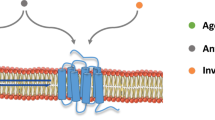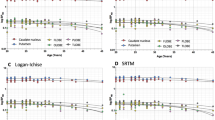Abstract
We investigated the distribution of serotonin (5-HT) receptors of type 3 (5-HT3) in human brain areas, by means of the the specific binding of [3H]GR65630. The brains were obtained during autoptic sessions from 6 subjects. Human brain membranes and the binding of [3H]GR65630 were carried out according to standardized methods. The highest density (Bmax ± 6 SD, fmol/mg protein) of [3H]GR65630 binding sites was found in area postrema (13.1 ± 9.7), followed at a statistically lower level, by nucleus tractus solitarius (6.7 ± 3.4), nervus vagus (5.5 ± 2.1), striatum (4.8 ± 2.4) with a progressive decrease in amygdala, olivar nuclei, hippocampus, olfactory bulbus and prefrontal cortex, and then by the other cortical areas and the cerebellum, where no binding was detected. These observations extend previous findings on the distribution of 5-HT3 receptors and confirm interspecies variations that might explain the heterogeneous properties of 5-HT3 receptors in different animals.
Similar content being viewed by others
REFERENCES
Boess, F. G. and Martin, I. L. 1994. Molecular biology of 5-HT receptors. Neuropharmacology 33:275–317.
Hoyer, D. and Martin, G. 1997. 5-HT receptor classification and nomenclature: towards a harmonization with the human genome. Neuropharmacology 36:419–428.
Kilpatrick, G. J., Jones, B. J., and Tyers, M. B. 1987. Identification and distribution of 5-HT3 receptors in rat brain using radioligand binding. Nature 330:746–748.
Kilpatrick, G. J., Jones, B. J., and Tyers, M. B. 1989. Binding of the 5-HT3 ligand [3H]GR65630, to rat area postrema, vagus nerve, and the brains of several species, Eur. J. Pharmacol. 159: 157–164.
Flechter, S. and Barne, N. M. 1999. Autoradiographic localization of [3H]-(S)-zacopride labelled 5-HT3 receptor in bovine brain. Neurosci. Lett. 269:91–94.
Jones, D. N. C., Barnes, N. M. Costall, B., Domeney, A. M., Kilpatrick, G. J., Naylor, R. J., and Tyers, M. B. 1992. The distribution of 5-HT3 receptor recognition sites in the marmoset brain. Eur. J. Pharmacol. 215:63–68.
Plosker, G. L. and Goa, K. L. 1991. Granisetron–a review of its pharmacological properties and therapeutic uses as an antiemetic. Drugs 42:805–824.
Bloom, F. E. and Morales, M. 1998. The central 5-HT3 receptor in CNS disorders. Neurochem. Res. 23:653–659.
Barnes, J. M., Barnes, N. M., and Cooper, S. J. 1992. Behavioral pharmacology of 5-HT3 receptors. Neurosci. Biobehav. Rev. 16:107–113.
Marazziti, D., Rossi, A., Palego, L., Giannaccini, G., Naccarato, A., Lucacchini, A., and Cassano, G. B. 1997. [3H]Ketanserin binding in human brain postmortem. Neurochem. Res. 22: 753–757.
Peterson G. L. 1977. A semplification of the protein assay method of Lowry et. al., which is more generally applicable. Anal. Biochem. 83:356–366.
Mc Pherson G. A. and Grant A., Kinetic, Ebda, Ligand, Lowry, A collection of radioligand binding analysis programs. Biosoft, Cambridge (1985).
Parker, R. M. C., Barnes, J. M., Ge, J., Barber, P. C., and Barnes N. M. 1996. Autoradiographic distribution of [3H]-(S)-zacopridelabelled 5-HT_3 receptors in human brain. J. Neurol. Sci. 144: 119–127.
Pratt, G. D., Bowery, N. G., Kilpatrick, G. J., Leslie, R. A., Barnes, N. M., Naylor, R. J., Jones, B. J., Nelson, D. R., Palacios, J. M., Slater, P. and Reynolds, J. M. 1990. The distribution of 5-HT3 receptors in mammalian hindbrain–a consensus. Trends Pharmacol. Sci. 11:135–137.
Waeber, C., Hoyer, D., and Palacios, J. M., 1989. 5-hydroxytryptamine3 receptors in the human brain: Autoradiographic visualization using [3H]-ICS 209-930, Neuroscience 31:393–400.
Perry, D. C. 1990. Autoradiography of [3H]-quipazine in rodent brain. Eur. J. Pharmacol. 187:75–80.
Gehlert, D. R., Gackenheimer, S. L., Wong, D. T. and Robertson, D. W. 1991. Localization of 5-HT3 receptors in the rat brain using [3H]-LY278584. Brain Res. 553:149–154.
Abi-Dargham, A., Laruelle, M., Wong, D. T., Robertson, D. W., Weinberger, D. R., and Kleinman, J. E. 1993. Pharmacological and regional characterization of [3H]LY278584 binding sites in human brain. J. Neurochem. 60:730–737.
Barnes, J. M., Barnes, N. M., Costall, B., Deakin, J. F., Ironside, J. W., Kilpatrick, G. J., Naylor, R. J., Rudd, J. A., Simpson, M. D., and Slater, P. 1990. Identification and distribution of 5-HT3 recognition sites within the human brain stem. Neurosci. Lett. 111:80–86.
Jacobsen, M. B. J. 1992. Ondansetron in carcinoid syndrome. Lancet 340:185.
Walsh, S. L. and Cunnigham, K. A. 1997. Serotonergic mechanisms involved in the discriminative stimulus, reinforcing and subjective effects of cocaine. Psychopharmacology 130:41–45.
Lovinger, D. M. 1999. 5-HT3 receptors and the neural actions of alcohols: an increasingly exciting topic. Neurochem. Int. 35: 125–130.
Author information
Authors and Affiliations
Rights and permissions
About this article
Cite this article
Marazziti, D., Betti, L., Giannaccini, G. et al. Distribution of [3H]GR65630 Binding in Human Brain Postmortem. Neurochem Res 26, 187–190 (2001). https://doi.org/10.1023/A:1010939530412
Issue Date:
DOI: https://doi.org/10.1023/A:1010939530412




